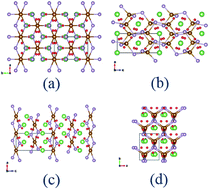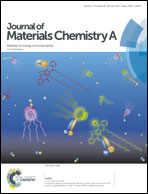A scheme for the generation of Fe–P networks to search for low-energy LiFePO4 crystal structures
Abstract
Herein we present a network generation scheme to explore the structural diversity of LiFePO4, which is an important cathode material in Li-ion batteries. With our scheme, networks of Fe and P atoms were initially constructed as the backbone structures using structural motifs for the FePx and FePx configurations, obtained from existing structural databases. Then, O atoms were added, resulting in the formation of PO4 tetrahedra and different types of Fe–O polyhedra. Finally, Li atoms were inserted into the vacancies within the generated FePO4 structures. We searched structures with FeO4, FeO5, or FeO6 polyhedra (unit cell with sizes of up to 4 formula units) and obtained ∼8 times more low-energy structures through our database than through existing databases. Furthermore, using our more comprehensive structural database, we unveiled a number of rules for identifying low-energy structures. These improved results complement the existing databases and are valuable for further research on structural transformations in similar materials by changing lithium or sodium cation populations.



 Please wait while we load your content...
Please wait while we load your content...